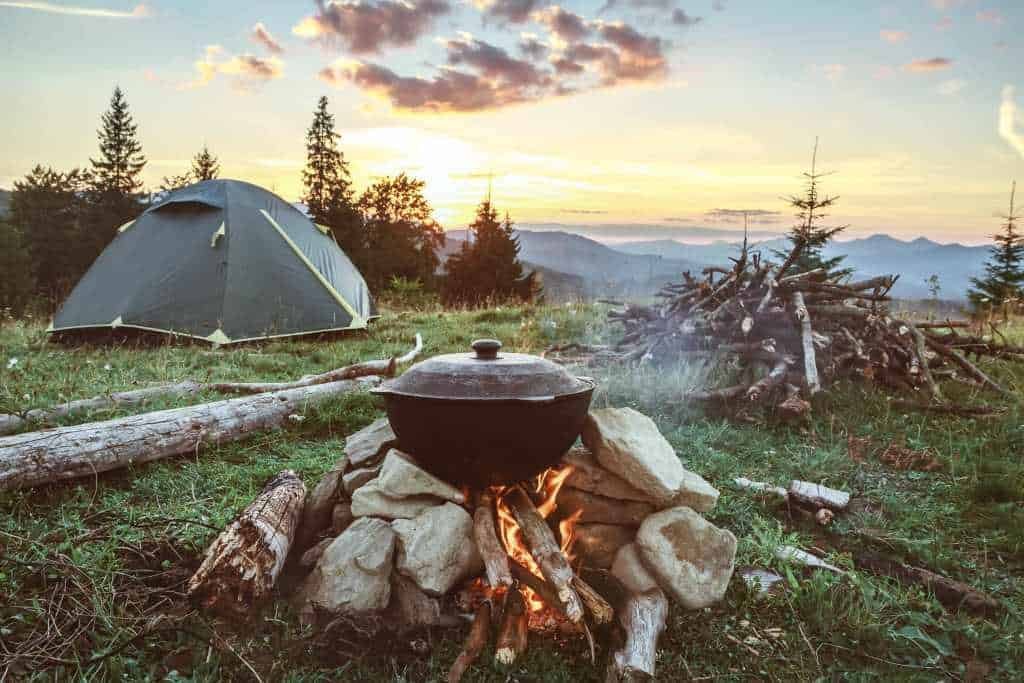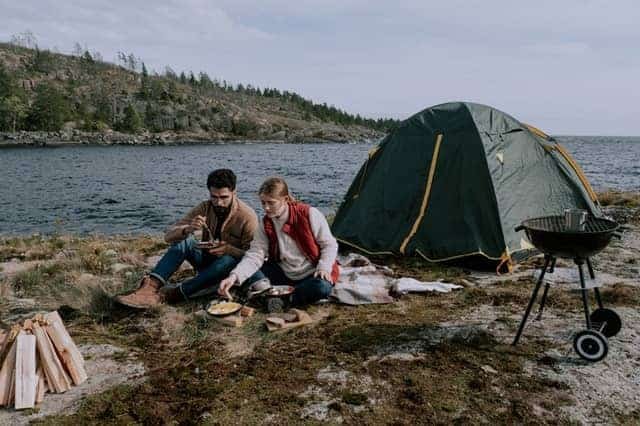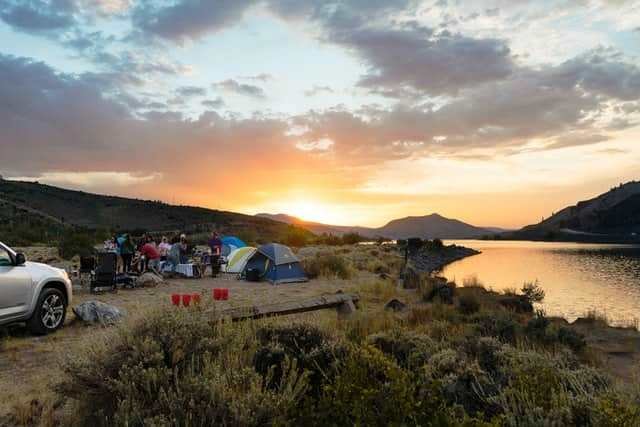Whether you’re setting out in the midst of summer or on a blue-bird winter day, there’s always a risk of that perfectly planned camping trip going downhill because of unforeseen conditions or inadequate preparation.
This article is for those of you who crave nature’s serenity but despise her brutal temps. We’ll lay out several different methods that you can employ to keep warm on your next camping trip.
How to Keep Warm When Camping
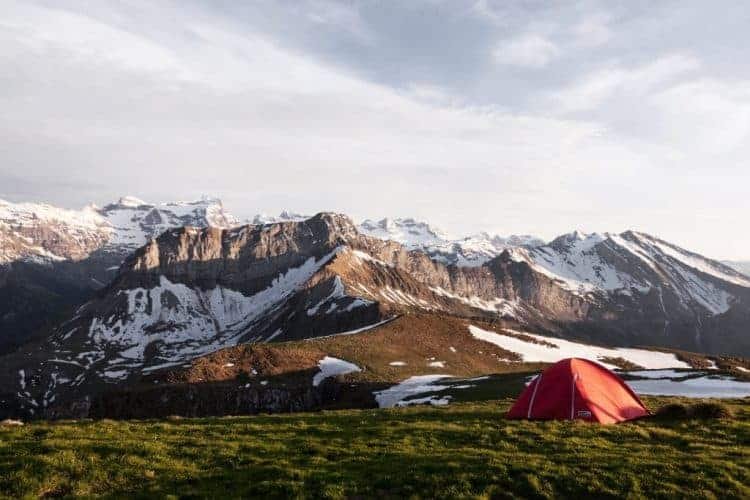
Image Source: unsplash.com
Plan Ahead
If you’re not already checking the weather to determine where you want to pitch your tent, then you should start to do so as soon as you’ve decided on a locale. Checking the weather regularly preceding your trip will allow you to notice patterns and generally gain an idea of what to expect.
Knowing what to expect (temperature, precipitation, etc.) will allow you to plan your gear accordingly. There’s nothing worse than expecting a cool, clear night under the stars instead of being greeted with a downpour and no rainfly!
Reduce Ambient Space in the Tent
You’ve probably heard the snide remark to someone’s vastly large house, “can you imagine the heating bill?” Well, the same principles apply to tent size: more unoccupied space means more space to heat.
By sacrificing extra space (that we agree is wonderful for the headroom or standing area) in selecting a smaller tent, you can reduce the ambient space and thereby increase the impact of the heat generated by your occupancy. To even further reduce ambient space, share the tent with another person, or consider what gear you can bring into your tent with you to take up some of the unused space.
Pick an Appropriate Sleeping Bag
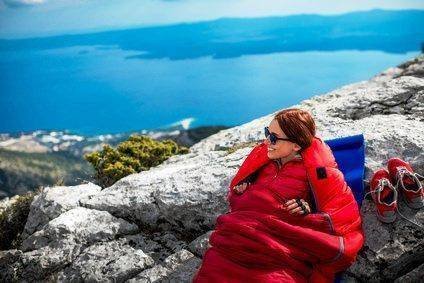
Almost directly related to our tip about checking the weather, choosing the right sleeping bag is one of the most straightforward ways to ensure a comfortable rest in cooler temps. We’ve already gathered the research to help you find a good quality cold-weather sleeping bag but read on to learn about how to make the most informed selection.
When shopping for a sleeping bag, make note of the EN (European Norm) rating. This was the original standard adopted by the sleeping bag industry to measure and assign the temperature ratings of sleeping bags.
Newer sleeping bags use the ISO (International Standards Organization) rating, but the testing methods are largely the same as those used for EN, therefore the EN and ISO ratings can be compared side by side.
Each of these rating entities, EN and ISO, provides two temperature ratings: Comfort and Lower Limit Rating.
Let’s start by taking a look at the Comfort Rating. This is the temperature where a cold sleeper is likely to feel comfortable when inside the sleeping bag.
On the other hand, the Lower Limit Rating is the temperature at which a warm sleeper is likely to feel comfortable.
Translation: if you tend to sleep cold or simply run cold, err on the side of the Comfort rating, or even consider a warmer bag in general. After all, you can always unzip or put a leg out to cool down if needed!
Bring an Insulated Sleeping Pad
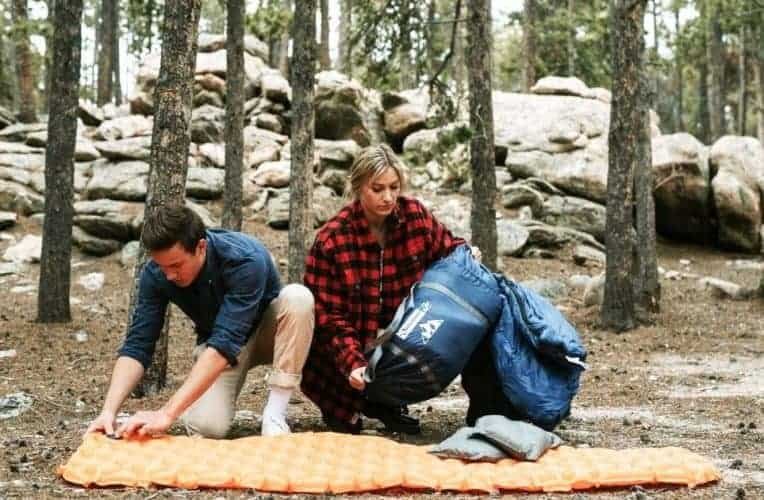
Almost as important as choosing your sleeping bag is deciding what to put under it! The ground beneath you can rob you of that hard-earned body heat, so be sure to pack an insulated sleeping pad.
This barrier will not only help you feel comfy-cozy through the night, but it will also block the cold from creeping into your bones and reflect your body heat to you.
In severely cold weather, you may also consider bringing two sleeping pads: one solid (i.e. foam pad) and one insulated inflatable pad. Not only are you doubly comfortable, but you are also ensuring even more warmth!
Keep Your Head Outside of Your Sleeping Bag
Have you noticed beads of water building up inside your tent overnight, or even how your car’s windows may fog up when you get in after walking in the rain? That is condensation caused by heat and moisture getting trapped inside where the air is cooler outside.
When you pull your oh-so-cozy sleeping bag over your head, thinking your nice warm breath is like winning the lottery for your heating bill, think again!
Each exhalation is creating that condensation inside your bag, creating moisture that ends up making you cooler, not to mention compromising the heating capability of your bag’s insulation. If you like a warm face or head when you’re sleeping, consider the use of a balaclava or a hat – and keep your bag only up to your chin.
Wear Appropriate Layers for Camping in Cold Weather

Your cool weather trip may call for rain, snow, wind, or just down-right brisk air. Be prepared by packing and wearing appropriate layers for the conditions. It’s great to layer up before you get coldーso yes, brave the cool just long enough to add layers because you won’t be getting any warmer the longer you stay out there dressed as-is.
A layering system will do you well here: wool or synthetic base layer pants and/or top (avoid cotton as it loses all heat-insulating properties once wet and takes longer to dry), medium to heavy-weight pants, mid-layer top (i.e. fleece), and a good outer layer.
If conditions call for precipitation, be sure to add a layer of rain repellency, such as waterproof pants, to avoid all your layers below getting wet. Finally, don’t forget nice, warm socks and something to cover your head and ears. This may seem like a lot, but layering allows you the flexibility to peel back when you get too warm without compromising your core temperature.
Prioritize Keeping Your Dry Gear Dry
In case you haven’t gotten the gist yet: stay dry to stay warm! The chances of gear drying once wet while out in cool weather are slim to none. And once wet, most of your gear intended to keep you warm will perform sub-par.
A good tip to maximize dryness is to pitch your tent first, with rainfly, then stow dry gear in the tent ASAP. Consider which items to leave in the vestibule versus those that go inside, remembering the lesson about condensation above.
If you are hiking into your campsite, either line the inside of your pack with a plastic bag or use a waterproof pack liner on the outside. Finally, try to put your tent in a place that will be less impacted by precipitation: under a tree or behind a windbreak are good places to look to minimize wetness.
Bring a Hot Water Bottle
Who said you can’t have a heater in the wilderness? If you brought a stove to cook with (fingers crossed that you did), then you should have the most crucial part of your camping heater! When it’s getting close to bedtime, boil water (or snow) and fill a heat-resistant water bottle with that steaming goodness.
Then put the bottle in your sleeping bag, maybe at the foot if your feet are struggling to stay cozy, and let it start doing its job while you get ready for bed. When you crawl in, you’ll have a head start on warming your sleeping bag, plus the source of something cozy to help you dream of the next trip out in cool weather!
Try Going to Bed Already Warm
In a similar vein as the note above about layering up before you’re cold, it’s valuable to hit the hay when you’re already warm. It will be more difficult for your body to generate heat while lying still, and it will take at least a few minutes for your sleeping bag to heat up.
Stay ahead of the curve by pre-heating your bag (see Hot Water Bottle tip), and not waiting until you’re too cold to think before retiring to your tent.
You may even consider doing a little physical activity to increase your circulation, like a few jumping jacks or squats so that your body is producing extra heat when you zip yourself in (just be sure not to break a sweat, because that moisture would negate all the effort!).
Final thoughts
Camping in cooler temperatures is rewarding beyond belief: fewer crowds, serenity, and vastly different landscapes. Make the most of this special occasion by ensuring your comfort all the way through, staying warm and dry so that you can enjoy what it’s all about!

